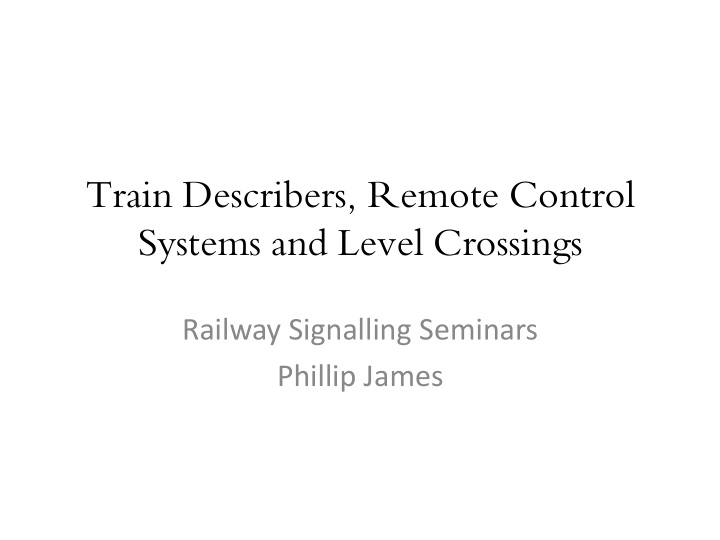



Train Describers, Remote Control Systems and Level Crossings Railway Signalling Seminars Phillip James
Overview • Train Describers. • Remote Control Systems. • Level Crossings.
Train Describers (ID’s for trains)
Train Location • Occupied track circuits highlighted red on VDU. • But no information on which train is where. • Job of the train describer is to keep track of this information.
Train Describers • Keeps track of trains entering/stepping through/leaving a section of railway. • Must receive and send signals to surrounding train describers. • Early Transmission for incoming trains allows routes to be set.
Example VDU Display
Calculations • Initial train positions entered via operators control unit. • Interlocking provides position information for steeping through. • Stepping through for routes provided from scheme plan via “Stepping” tables.
Remote Control Systems (For changing the tv channels on carriages with tv’s )
Expensive business Problem: Physical distance between signalling centre and interlocking introduces cost (many cables over long distance). Solution: Remote control systems (1950’s) – Allow multiple signals along a single pair of cables.
Time Division Multiplex System Multiple signals sent along same cable at synchronised time intervals. Note: No need to be fail-safe as interlocking is still around!
Frequency Division Multiplex System Transmitter/receiver pair for certain frequencies. Non overlapping frequencies can be sent in parallel.
Level Crossings (The comeback for the pelican.)
Super/Sub Types and Disjoint Top Sorts Level crossings come in all shapes and sizes thanks to: – Location – Usage – Speed – Electrification
The Gates Example • Gates controlled by railway staff. • Signal only clears for train when gate closed.
The Barrier Example • Electronic barriers (usually) controlled remotely. • Signal for traffic and pedestrians.
Wig-Wag Signals • Amber before barriers begin to lower. • Flashing red when lowering and lowered.
The Automatic Half Barrier • Same sequence as barrier, but automatically initiated when trains pass “Strike - in” point. • Notice barrier only covers half of the road.
Automatic Open Crossings • NO barriers – only traffic lights. • Local operation through plunger. • Additional signals for trains indicate problem.
Summary • Train Describers – implementation details of identifiers. • Remote Control Systems – time/freq multiplexing. • Level Crossings – Infinitely many examples.... Next: Nga – Automatic Train Control.
Recommend
More recommend